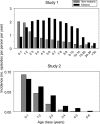Heritability of malaria in Africa
- PMID: 16259530
- PMCID: PMC1277928
- DOI: 10.1371/journal.pmed.0020340
Heritability of malaria in Africa
Abstract
Background: While many individual genes have been identified that confer protection against malaria, the overall impact of host genetics on malarial risk remains unknown.
Methods and findings: We have used pedigree-based genetic variance component analysis to determine the relative contributions of genetic and other factors to the variability in incidence of malaria and other infectious diseases in two cohorts of children living on the coast of Kenya. In the first, we monitored the incidence of mild clinical malaria and other febrile diseases through active surveillance of 640 children 10 y old or younger, living in 77 different households for an average of 2.7 y. In the second, we recorded hospital admissions with malaria and other infectious diseases in a birth cohort of 2,914 children for an average of 4.1 y. Mean annual incidence rates for mild and hospital-admitted malaria were 1.6 and 0.054 episodes per person per year, respectively. Twenty-four percent and 25% of the total variation in these outcomes was explained by additively acting host genes, and household explained a further 29% and 14%, respectively. The haemoglobin S gene explained only 2% of the total variation. For nonmalarial infections, additive genetics explained 39% and 13% of the variability in fevers and hospital-admitted infections, while household explained a further 9% and 30%, respectively.
Conclusion: Genetic and unidentified household factors each accounted for around one quarter of the total variability in malaria incidence in our study population. The genetic effect was well beyond that explained by the anticipated effects of the haemoglobinopathies alone, suggesting the existence of many protective genes, each individually resulting in small population effects. While studying these genes may well provide insights into pathogenesis and resistance in human malaria, identifying and tackling the household effects must be the more efficient route to reducing the burden of disease in malaria-endemic areas.
Conflict of interest statement
Figures


References
-
- Jepson A, Banya W, Sisay-Joof F, Hassan-King M, Bennett S, et al. Genetic regulation of fever in Plasmodium falciparum malaria in Gambian twin children. J Infect Dis. 1995;172:316–319. - PubMed
-
- Stirnadel HA, Al-Yaman F, Genton B, Alpers MP, Smith TA. Assessment of different sources of variation in the antibody responses to specific malaria antigens in children in Papua New Guinea. Int J Epidemiol. 2000;29:579–586. - PubMed
-
- Garcia A, Dieng AB, Rouget F, Migot-Nabias F, Le Hesran JY, et al. Role of environment and behaviour in familial resemblances of Plasmodium falciparum infection in a population of Senegalese children. Microbes Infect. 2005;6:68–75. - PubMed
-
- Ranque S, Safeukui I, Poudiougou B, Traoré A, Keita M, et al. Familial aggregation of cerebral malaria and severe malarial anemia. J Infect Dis. 2005;191:799–804. - PubMed
Publication types
MeSH terms
Substances
Grants and funding
LinkOut - more resources
Full Text Sources
Other Literature Sources
Medical

